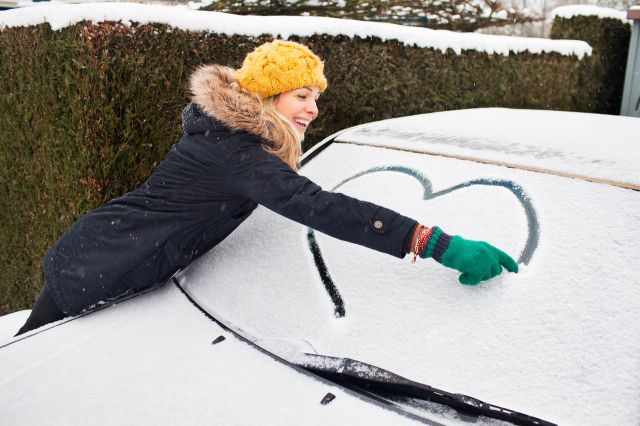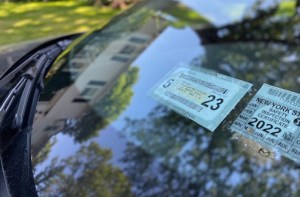An icy windshield can be expected on a frigid winter morning, but it’s not exactly welcome (especially if defrosting is going to make you late.) While windshield wipers may take care of a light freeze, wipers or even an ice scraper alone are no match for a thick layer of ice. That’s when you’ll need to use winter wash fluid.
Learn how windshield de-icers work so you can be safely on your way.
Standard Windshield Wiper Fluid vs. De-icers
The type of fluid you choose to put in your wiper fluid reservoir may not seem important, but it makes a big difference when you’re trying to deal with winter weather. Standard windshield wiper fluid is designed to clean – whether it’s dirt, road grime or bug guts – but it’s not especially effective at breaking through ice and may freeze in cold weather, causing damage to the washer system.
In winter, use winter wash fluid, a washer fluid that’s also marked as a de-icer and remains liquid at temperatures down to at least minus 20 degrees. These are specially formulated to protect against freezing and can melt a thin layer of ice. Some popular brands include Rain-X, Peak and Prestone.
How Do Windshield De-Icers Work?
Using a winter wash fluid helps to quickly clear light ice and keeps it from building up as you drive. However, it might not be enough to break through a thick coat of ice on its own.
You can take out the ice scraper, which is smart to have in your car in the winter months, but there are also spray-on de-icers to make short work of the job. Simply spray the windshield with the de-icer, and within a few moments, the ice will start to melt. After that, all you need to do is hop behind the wheel and turn on the wipers to clear the last of the ice.
Some de-icers conveniently come with a built-in ice scraper.
What Not to Do to Clear the Ice
Never put hot water on your windshield to melt the ice.
Yes, hot water melts stuff, but you don’t ever want to put hot water on your windshield. Not even a little bit. Heat makes things expand and throwing hot water on a cold windshield makes the glass expand very quickly. This can cause your windshield to crack, sometimes in very dramatic fashion.
Even if the windshield doesn’t break, this method leaves you with a wet pane of glass, which is likely to refreeze and leave you right where you started.
An Ounce of Prevention
If there’s the option to park your car in a garage, then that’s where it should be parked. Even a covered car port can reduce or eliminate the amount of ice that builds up on your windshield. Failing those two options, you can simply cover the windshield. A tarp or large towel will do the trick, just make sure it’s secured so it doesn’t blow away in the middle of the night. Tucking it under the wipers is usually enough to keep it in place.
Windshield covers are readily available at most auto supply stores and come weighted or with built-in magnets. But be careful – if your car is dirty, any grit trapped between the magnet and the metal could scratch the finish of your vehicle.
Use your AAA discount to save at NAPA Auto Parts.
A Word on Safety
Wiper fluid, winter wash fluid and most kinds of sprays contain chemicals, such as alcohol, which are potentially harmful and in some cases flammable. Avoid contact with your skin and eyes, don’t inhale the fumes and make sure children and pets aren’t exposed to these treatments, especially if something drips onto the ground. The alcohol in some spray de-icers can also remove wax. Cleaning the car and reapplying wax when the weather gets warmer is time well spent.
It’s also important to fully and completely clear your windshield (and entire car) of ice before you drive away. Do not be the person with a tiny peephole scraped into the ice at eye level. The windshield needs to be free of ice so you can see the road and everything around you. Not clearing your windshield could get you pulled over by the authorities and, depending on where you live, include a hefty fine. It’s better to be a few minutes late than risk a crash.
Now that you know how windshield de-icers work, learn how to clear snow and ice from the rest of your car.
One Thought on “How Do Windshield De-Icers Work?”
Leave A Comment
Comments are subject to moderation and may or may not be published at the editor’s discretion. Only comments that are relevant to the article and add value to the Your AAA community will be considered. Comments may be edited for clarity and length.













One thing that I’ve noticed though is when you use the de-icer, the rapid decrease in temperature causes the inside to fog heavily. So you still have to wait until your defrosters can clear the frost. ( It actually causes super cooling), I have had better luck spraying the windshield the night before a freeze up is expected. The ice tends to just brush right off in the morning or at least with less resistance and chance of scratching the glass.